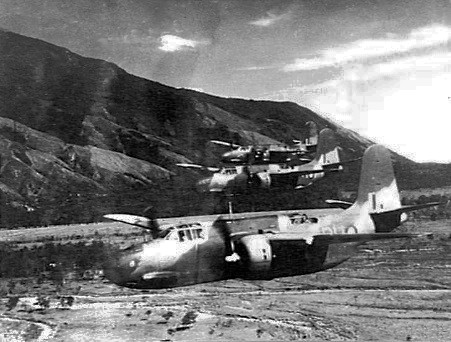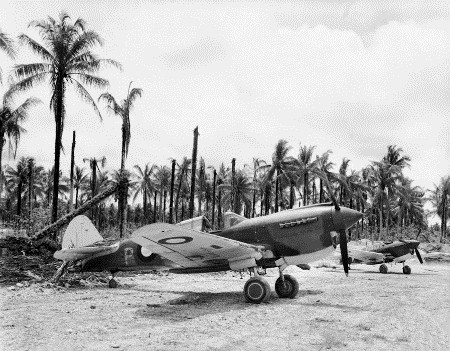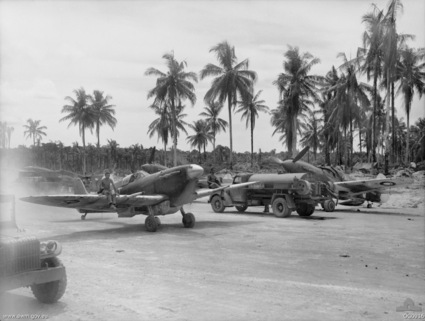No. 73 Wing RAAF on:
[Wikipedia]
[Google]
[Amazon]
No. 73 Wing was a
 Formed in February 1943, No. 73 Wing consisted of No. 4 Squadron (flying
Formed in February 1943, No. 73 Wing consisted of No. 4 Squadron (flying
''Air War Against Japan'', pp.23–24
/ref>Stephens, ''The Royal Australian Air Force'', pp.122–123 In March 1943, No. 73 Wing's units participated in the
''Royal Australian Air Force'', pp.690–692
/ref>Wilson, ''The Brotherhood of Airmen'', pp.125–127 Having earlier been led by Wing Commander Blake Pelly, by June 1943 No. 73 Wing was under the command of Group Captain
Having earlier been led by Wing Commander Blake Pelly, by June 1943 No. 73 Wing was under the command of Group Captain
 Wing Commander Gordon Steege assumed command of No. 73 Wing in October 1943.Air Commodore Gordon Henry Steege
Wing Commander Gordon Steege assumed command of No. 73 Wing in October 1943.Air Commodore Gordon Henry Steege
at Australian War Memorial. Retrieved on 24 November 2010. Minimal offensive air activity by the Japanese meant that No. 79 Squadron's Spitfires saw relatively little action, while in contrast the wing's P-40s with their ground attack capability were "fully engaged". As part of the build-up to the Battle of Arawe in December, the Kittyhawks launched a series of attacks on the
''Air War Against Japan'', p.249
/ref>AWM, ''Squadrons, Formations & Units of the Royal Australian Air Force and Their Deployment'', p.119 Its combat units were all eventually transferred to other formations under No. 10 Operational Group (later renamed the79 Squadron RAAF
at Australian War Memorial. Retrieved on 24 November 2010.
Royal Australian Air Force
"Through Adversity to the Stars"
, colours =
, colours_label =
, march =
, mascot =
, anniversaries = RAAF Anniversary Commemoration ...
(RAAF) wing
A wing is a type of fin that produces lift while moving through air or some other fluid. Accordingly, wings have streamlined cross-sections that are subject to aerodynamic forces and act as airfoils. A wing's aerodynamic efficiency is e ...
of World War II. It was formed in February 1943 at Port Moresby
(; Tok Pisin: ''Pot Mosbi''), also referred to as Pom City or simply Moresby, is the capital and largest city of Papua New Guinea. It is one of the largest cities in the southwestern Pacific (along with Jayapura) outside of Australia and New ...
, Papua New Guinea, as part of No. 9 Operational Group. The wing initially comprised three attack squadrons flying CAC Wirraway
The CAC Wirraway (an Aboriginal word meaning "challenge") was a training and general purpose military aircraft manufactured in Australia by the Commonwealth Aircraft Corporation (CAC) between 1939 and 1946. It was an Australian development of ...
s, Douglas Bostons, and Bristol Beaufighters, with which it took part in the New Guinea campaign until mid-year. It was then reorganised with three fighter squadrons operating P-40 Kittyhawks and Supermarine Spitfires; in this form it saw action in the New Britain and Admiralty Islands campaign
The Admiralty Islands campaign (Operation Brewer) was a series of battles in the New Guinea campaign of World War II in which the United States Army's 1st Cavalry Division took the Japanese-held Admiralty Islands.
Acting on reports from ai ...
s through 1943–44. The wing was disbanded at Los Negros
Los Negros ('The Black Ones') was a criminal organization that was once the armed wing of the Sinaloa Cartel and after a switch of alliances, became the armed wing of the Sinaloa splinter gang, the Beltrán-Leyva Cartel. In 2010 it went indepe ...
in August 1944, and by the beginning of 1945 its squadrons had been absorbed into other RAAF wings under No. 10 Operational Group (later the Australian First Tactical Air Force
The Australian First Tactical Air Force (No. 1 TAF) was formed on 25 October 1944 by the Royal Australian Air Force (RAAF). Its purpose was to provide a mobile force of fighter and ground attack aircraft that could support Allied army and n ...
).
History
New Guinea campaign
 Formed in February 1943, No. 73 Wing consisted of No. 4 Squadron (flying
Formed in February 1943, No. 73 Wing consisted of No. 4 Squadron (flying CAC Wirraway
The CAC Wirraway (an Aboriginal word meaning "challenge") was a training and general purpose military aircraft manufactured in Australia by the Commonwealth Aircraft Corporation (CAC) between 1939 and 1946. It was an Australian development of ...
s), No. 22 Squadron ( Douglas Bostons) and No. 30 Squadron ( Bristol Beaufighters). Based at Port Moresby
(; Tok Pisin: ''Pot Mosbi''), also referred to as Pom City or simply Moresby, is the capital and largest city of Papua New Guinea. It is one of the largest cities in the southwestern Pacific (along with Jayapura) outside of Australia and New ...
, Papua New Guinea, the wing was under the control of No. 9 Operational Group, the RAAF's "premier fighting unit" in the South West Pacific Area
South West Pacific Area (SWPA) was the name given to the Allied supreme military command in the South West Pacific Theatre of World War II. It was one of four major Allied commands in the Pacific War. SWPA included the Philippines, Borneo, the ...
(SWPA), whose purpose was to act as a mobile strike force in support of advancing Allied troops.Odgers''Air War Against Japan'', pp.23–24
/ref>Stephens, ''The Royal Australian Air Force'', pp.122–123 In March 1943, No. 73 Wing's units participated in the
Battle of the Bismarck Sea
The Battle of the Bismarck Sea (2–4 March 1943) took place in the South West Pacific Area (SWPA) during World War II when aircraft of the U.S. Fifth Air Force and the Royal Australian Air Force (RAAF) attacked a Japanese convoy carrying troop ...
, "the decisive aerial engagement" in the SWPA according to General Douglas MacArthur, that resulted in twelve ships from a Japanese convoy being sunk. During this engagement, some of No. 22 Squadron's Bostons struck Lae airfield to prevent Japanese fighters taking off to intercept Allied bombers, while others took part in the actual assault on the convoy; No. 30 Squadron's Beaufighters launched "withering" low-level cannon and machine-gun attacks on the Japanese ships to suppress anti-aircraft fire prior to bombing runs by USAAF B-25 Mitchells. Flight Lieutenant Bill Newton
William Ellis Newton, VC (8 June 1919 – 29 March 1943) was an Australian recipient of the Victoria Cross, the highest decoration for gallantry in the face of the enemy that can be awarded to a member of the British and Com ...
, one of the Boston pilots who attacked Lae, was awarded a posthumous Victoria Cross
The Victoria Cross (VC) is the highest and most prestigious award of the British honours system. It is awarded for valour "in the presence of the enemy" to members of the British Armed Forces and may be awarded posthumously. It was previously ...
for pressing home bombing missions against Salamaua
Salamaua () was a small town situated on the northeastern coastline of Papua New Guinea, in Salamaua Rural LLG, Morobe province. The settlement was built on a minor isthmus between the coast with mountains on the inland side and a headland. The c ...
later that month, in spite of severe damage to his aircraft.Stephens, ''The Royal Australian Air Force'', pp.160–165Gillison''Royal Australian Air Force'', pp.690–692
/ref>Wilson, ''The Brotherhood of Airmen'', pp.125–127
 Having earlier been led by Wing Commander Blake Pelly, by June 1943 No. 73 Wing was under the command of Group Captain
Having earlier been led by Wing Commander Blake Pelly, by June 1943 No. 73 Wing was under the command of Group Captain Ian McLachlan
Ian Murray McLachlan (born 2 October 1936) is a former Australian politician who served as a member of the House of Representatives from 1990 to 1998, representing the Liberal Party. He was Minister for Defence in the Howard Government from ...
. That month, McLachlan established his headquarters at Goodenough Island
Goodenough Island in the Solomon Sea, also known as Nidula Island, is the westernmost of the three large islands of the D'Entrecasteaux Islands in Milne Bay Province of Papua New Guinea. It lies to the east of mainland New Guinea and southwest ...
, where the wing was reorganised as a fighter formation consisting of No. 76 Squadron (flying P-40 Kittyhawks), No. 77 Squadron (Kittyhawks) and No. 79 Squadron ( Supermarine Spitfires). As well as providing local air defence, defending the naval forces assigned to Operation Chronicle
Operation Chronicle was the Allied invasion of Woodlark and Kiriwina Islands, in the South West Pacific, during World War II. The operation was a subordinate action that formed part of the wider Operation Cartwheel, the advance towards Rabau ...
, and fighter escort for Australian bombers, the Kittyhawks were themselves armed with incendiary and general-purpose bombs so that they could engage in ground-attack
In military tactics, close air support (CAS) is defined as air action such as air strikes by fixed or rotary-winged aircraft against hostile targets near friendly forces and require detailed integration of each air mission with fire and movem ...
missions, a practice that had already been employed by Commonwealth forces in the Mediterranean and Middle East Theatre
The Mediterranean and Middle East Theatre was a major theatre of operations during the Second World War. The vast size of the Mediterranean and Middle East theatre saw interconnected naval, land, and air campaigns fought for control of the Medi ...
.
In August 1943, the wing transferred to Kiriwina
Kiriwina is the largest of the Trobriand Islands, with an area of 290.5 km². It is part of the Milne Bay Province of Papua New Guinea. Most of the 12,000 people who live in the Trobriands live on Kiriwina. The Kilivila language, also known ...
, while No. 9 Group's other combat formation, No. 71 Wing, took over responsibility for Goodenough. Transport delays meant that No. 77 Squadron remained at Goodenough, however, and its place in No. 73 Wing at Kiriwina was taken by No. 78 Squadron, which arrived from Australia in November, also equipped with Kittyhawks.
New Britain and Admiralty Islands campaigns
 Wing Commander Gordon Steege assumed command of No. 73 Wing in October 1943.Air Commodore Gordon Henry Steege
Wing Commander Gordon Steege assumed command of No. 73 Wing in October 1943.Air Commodore Gordon Henry Steegeat Australian War Memorial. Retrieved on 24 November 2010. Minimal offensive air activity by the Japanese meant that No. 79 Squadron's Spitfires saw relatively little action, while in contrast the wing's P-40s with their ground attack capability were "fully engaged". As part of the build-up to the Battle of Arawe in December, the Kittyhawks launched a series of attacks on the
Gasmata Gasmata is a village on the southern coast of New Britain, Papua New Guinea located at 6° 16' 60S 150° 19' 60E. There is a Gasmata Airport in Surumi Peninsula area adjacent. The village is administered under Gasmata Rural LLG in East New Britain ...
airfield and fuel dumps; on the day of the Allied landings, as No. 76 Squadron Kittyhawks patrolled above the beaches, the Spitfires remained at Kiriwina in case of strikes by Japanese raiders, though none came. In January 1944, the wing's Spitfires and Kittyhawks accompanied Beauforts on the two largest raids mounted by the RAAF to that time, each involving over 70 aircraft attacking enemy camps and depots at Lindenhafen, New Britain.
As part of No. 9 Group's contribution to the Admiralty Islands campaign
The Admiralty Islands campaign (Operation Brewer) was a series of battles in the New Guinea campaign of World War II in which the United States Army's 1st Cavalry Division took the Japanese-held Admiralty Islands.
Acting on reports from ai ...
, No. 73 Wing took up garrison duties at Los Negros
Los Negros ('The Black Ones') was a criminal organization that was once the armed wing of the Sinaloa Cartel and after a switch of alliances, became the armed wing of the Sinaloa splinter gang, the Beltrán-Leyva Cartel. In 2010 it went indepe ...
commencing in March 1944. Its complement of combat squadrons was again Nos. 76, 77 and 79 Squadrons, supported by No. 49 Operational Base Unit, No. 114 Mobile Fighter Sector, No. 27 Air Stores Park and No. 26 Medical Clearing Station, among other ancillaries, with total ground staff numbering approximately 900. The fighters' primary duty was providing air cover for Allied shipping; they also carried out bomber escort, ground attack and anti-shipping missions in the region. In mid-April, the wing escorted the largest Allied convoy in the South-West Pacific to that date, 80 ships carrying 30,000 personnel, from Finschhafen
Finschhafen is a town east of Lae on the Huon Peninsula in Morobe Province of Papua New Guinea. The town is commonly misspelt as Finschafen or Finschaven. During World War II, the town was also referred to as Fitch Haven in the logs of some U.S ...
to Aitape. Completing its garrison work in the Admiralties that June, No. 73 Wing was disbanded at Los Negros on 29 August 1944.Odgers''Air War Against Japan'', p.249
/ref>AWM, ''Squadrons, Formations & Units of the Royal Australian Air Force and Their Deployment'', p.119 Its combat units were all eventually transferred to other formations under No. 10 Operational Group (later renamed the
Australian First Tactical Air Force
The Australian First Tactical Air Force (No. 1 TAF) was formed on 25 October 1944 by the Royal Australian Air Force (RAAF). Its purpose was to provide a mobile force of fighter and ground attack aircraft that could support Allied army and n ...
). Nos. 76 and 77 Squadrons joined another Kittyhawk unit, No. 82 Squadron, at No. 81 Wing on Noemfoor under Steege's command, while No. 79 Squadron was withdrawn to Darwin in November to re-equip with new Spitfires before joining No. 80 Wing and returning to the Pacific at Morotai in March 1945.at Australian War Memorial. Retrieved on 24 November 2010.
Notes
References
* * * * * *Further reading
* {{Use dmy dates, date=June 2017 73 Military units and formations established in 1943 Military units and formations disestablished in 1944